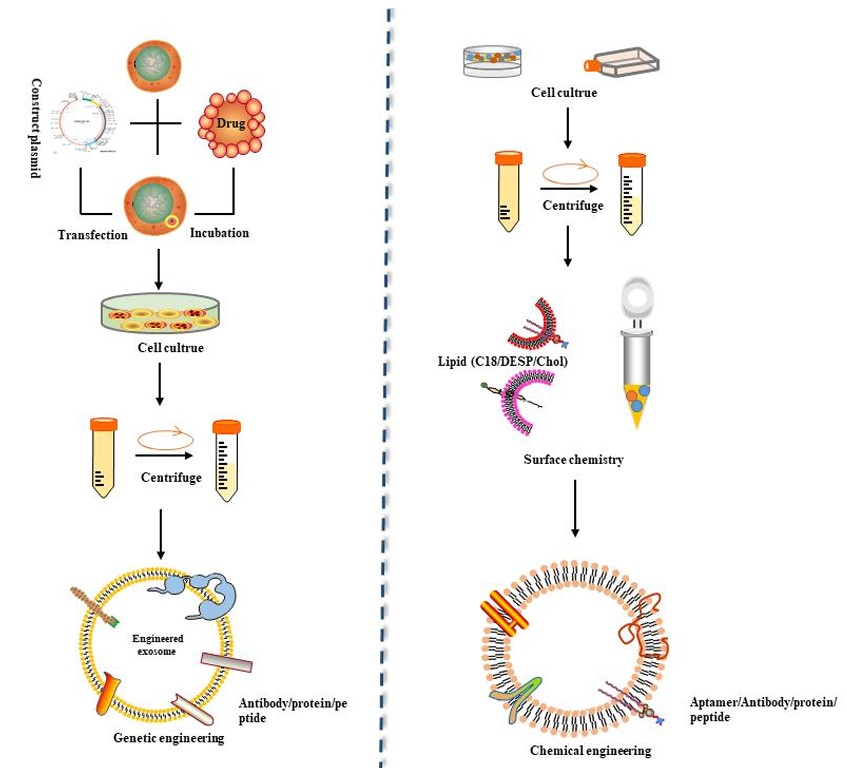Exosome Display-based Targeted Delivery Service
Overview Services Features FAQs
Exosome display technology can manipulate the molecular composition of the exosomes and tailor them with new desirable properties. Creative Biolabs offers high-quality development services for targeted exosomes based on exosome display technology to promote research in the targeted delivery of genes or drug delivery.
Exosome Display Technology for Exosome Targeting
One of the most attractive applications of exosome display technology is to produce exosomes bearing target ligands or homing peptides specific to recipient cells. The ligands or homing peptides can be inserted into the transmembrane proteins enriched on the surface of exosomes to form the fusion protein, subsequently, the fusion proteins are inserted into plasmids to transfect cells. The transfection cells will secrete the exosomes bearing the target ligands or homing peptides which have the targeting capability to cognate receptor cells. There is a lot of opportunity to investigate the potential use of exosomes for targeted gene therapy, especially with the identification of several peptides that homing to sick tissues or organs using phage display and in vivo or in vitro biopanning methods.
 Fig. 1 Schematic representation of the primary strategies for engineering exosomes displaying targeting ligands.1
Fig. 1 Schematic representation of the primary strategies for engineering exosomes displaying targeting ligands.1
What Can We Do?
Creative Biolabs offers tailored services for producing exosomes with specific targets using the exosome display technology.
-
Exosome-targeting peptide identification
It is key for the identification of exosome-targeting peptides, which facilitates the effective and functional display on the exosome surface and further promotes the process of exosome targeting.
-
Construction of Recombination Exosomes
Based on exosome display technology, we can utilize the different exosomal transmembrane proteins (Lactadherin, LAMP-2b, and PDGFR) for fusion with a variety of interest ligands or homing peptides. The fusion proteins can be effectively displayed on the surface of exosomes.
Features
-
Custom-specific project designs that allow targeting to different tissues by using appropriate tissue-specific targeting moieties fused to different exosomal membrane proteins
-
Professional scientists collaborate closely with clients to deliver gratifying customer care support.
-
Excellent and reasonably priced services
-
The greatest post-purchase assistance
Creative Biolabs has abundant experience in exosome-related research and has a comprehensive suite of research programs to aid in the brilliant studies of our clients. Please contact us and start the conversation.
FAQs
Q: What is Targeted Delivery based on Exosome Display?
A: Exosome Display-based Targeted Delivery is a cutting-edge technique where exosomes, naturally occurring vesicles, are engineered to display specific proteins or peptides on their surface. The therapeutic cargo can then be targeted and delivered to particular cells or tissues by these altered exosomes.
Q: How does Exosome Display-based Targeted Delivery work?
A: Targeting ligands are expressed on the surface of exosomes through genetic modification, a process known as exosome display. These ligands can be antibodies, peptides, or other molecules that recognize receptors on target cells. Once engineered, these exosomes can selectively deliver payloads such as drugs or genetic material to desired cell types.
Q: What are the advantages of using Exosome Display-based Targeted Delivery?
A: This approach offers several advantages including enhanced specificity, reduced off-target effects, and improved therapeutic efficacy compared to traditional delivery methods. It makes use of exosomes' inherent qualities to target specific targets and deliver therapeutic substances effectively.
Q: What types of payloads can be delivered using Exosome Display-based Targeted Delivery?
A: Exosome Display can be used to deliver a variety of payloads including small molecules, RNA, DNA, proteins, and nanoparticles. The choice of payload depends on the therapeutic application and the specific targeting strategy employed.
Reference
-
Xie, Shenmin, Qin Zhang, and Li Jiang. "Current knowledge on exosome biogenesis, cargo-sorting mechanism and therapeutic implications." Membranes 12.5 (2022): 498. Under Open Access license CC BY 4.0. The image was modified by revising the title.
For Research Use Only. Cannot be used by patients.
Related Services:

 Fig. 1 Schematic representation of the primary strategies for engineering exosomes displaying targeting ligands.1
Fig. 1 Schematic representation of the primary strategies for engineering exosomes displaying targeting ligands.1









